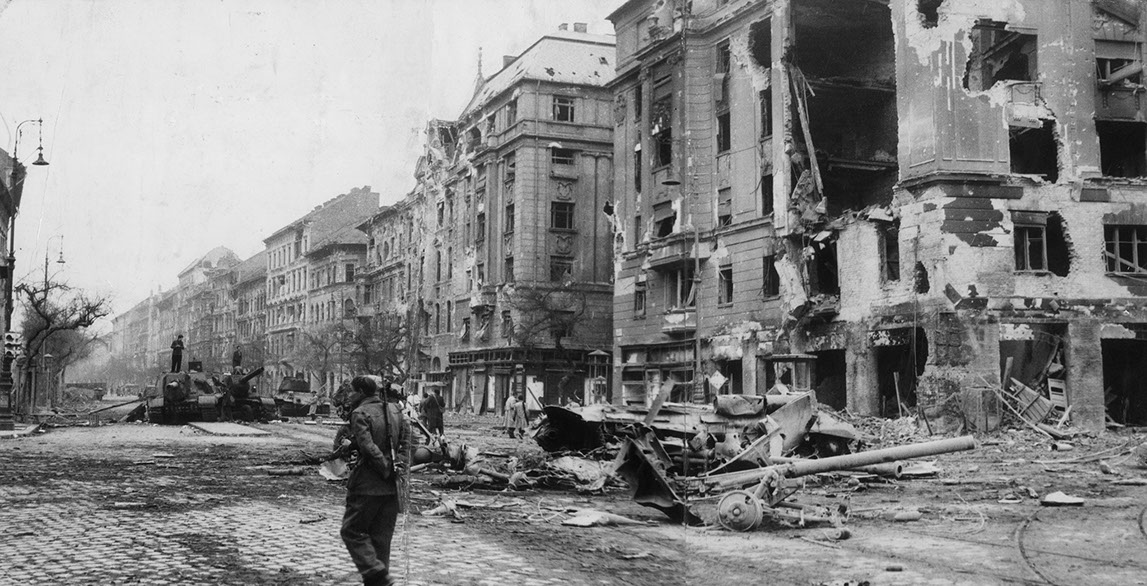OVERVIEW
01
SOVIET ‘ANTI-FASCISM’ & A DISTRUST FOR NATIONALISM
Anti-fascism becomes central to the political order of the Soviet Union and at its core is a charred distrust of nationalism.
The 1956 Hungarian Uprising marks the first major revolt against the Soviet ruled communist system.
READ THIS PART
02
WESTERN EUROPE’S
VISION OF UNITY
The Schuman Plan of 1950 leads to the establishment of the European Coal and Steel Community (ECSC) in 1952.
The 1957 Treaty of Rome then transforms the six nations of the ECSC, into the European Economic Community (EEC) in 1958.
READ THIS PART
03
COVERT CIA FUNDING TOWARDS A ‘UNITED STATES OF EUROPE’
In secret, the US funnels millions of dollars into the European project via the American Committee for a United Europe (ACUE) - a CIA front organisation - in the hope that a united Europe would serve as a bulwark against Soviet aggression.
READ THIS PART

THE BIG PICTURE: THE MAKING AND BREAKING OF EUROPE
01
Soviet anti-fascism & a distrust for nationalism
>
Delegates at the signing of the European Common Market Treaty in Rome. | PHOTO BY KEYSTONE/GETTY IMAGES
“Anti-fascism becomes anti-westernism”
DAN STONE
By the 1950s, the division of Europe into two ideological blocs is a political, economic and cultural reality.
Anti-fascism becomes the basis of stability and the main legitimating myth of the Soviet Union – fascism is seen as a crisis of capitalism.
At the core of Soviet anti-fascism lay a charred distrust of nationalism. But the communist hierarchy, now under Nikita Khrushchev, was quick to understand that national traditions had political value.
INTERVIEW
“The European continent becomes a battleground between sort of, if you like, American, Anglo-American influence that’s trying to uphold and expand liberal democracy versus Soviet communism, which is really tied up with anti-fascism.”
Matthew Goodwin
INTERVIEW
“Instead of suppressing those traditions, the cultural traditions, at one point in the 1950s and 60s the Soviet Union decided to let them flourish a bit, all under the Soviet umbrella where you can explore your like national food, national culture and music etc, and that wasn't reprimanded or oppressed. People were allowed to explore, you know, soft versions of nationalism and cultural versions but anything political was deeply frowned upon, not just frowned upon but repressed aggressively by the Soviet state.”
Alina Polyakova
WATCH
Nationalism was tolerated by the communist regime when it served a purpose.
But when that purpose was in the interests of sovereignty, tolerance turned to belligerence.
BACKGROUND
BUDAPEST UPRISING 1956: A RIP IN THE IRON CURTAIN
The 1956 Hungarian Uprising (Oct 23 - Nov 10) was an almost spontaneous revolt by the Hungarian people against the Soviet policies of the ruling Communist Party. Despite starting as a student demonstration, the revolt quickly spread across Hungary, leading to the collapse of the government. But the Soviet army soon regrouped and launched an all-out assault bringing a brutal end to nearly three weeks of protests and political instability in Hungary.
Conservative figures estimate that 3,000 Hungarian civilians - men, women, children - were killed.
INTERVIEW
“In Budapest, for example, in 1956, and don’t forget that’s only 10 years after the war, the uprising, which is genuinely an attempt to take Hungary out of the Warsaw Pact and to reintroduce a form of parliamentary democracy, is condemned by hardliners within the Hungarian regime and by Moscow as the work of fascists. So, anti-fascism is becoming anti-Westernism.”
Dan Stone
WATCH



Young Hungarians holding a Hungarian flag standing on a fallen statue at Budapest during the Uprising. | PHOTO BY KEYSTONE/GETTY IMAGES
31st October 1956: Baross Strasser in the centre of Budapest showing the devastation caused by the anti-communist battle for freedom. | PHOTO BY KEYSTONE/GETTY IMAGES
3rd November 1956: A huge statue of Stalin is dismantled near the National Theatre as Hungarians rebel against Soviet rule. | PHOTO BY KEYSTONE/GETTY IMAGES
1 - 3
<
>
click to expand
02
Western Europe's vision of unity
>
Portrait of Jean Monnet, French General Commissioner for Economic Development, circa 1950. | PHOTO BY PICTORIAL PARADE/HULTON ARCHIVE/GETTY IMAGES
“Jean Monnet’s idea was to create a supranational authority to hive off coal and steel, which were seen at that time
as the sinews of war”
GEORGE SCHOPFLIN
ARCHIVE
“Europe will not be made all at once, or according to a single plan. It will be built through concrete achievements which first create a de facto solidarity.”
Robert Schuman
In May 1950, two years after the Marshall Plan had been put into effect, France’s Foreign Minister Robert Schuman, laid bare the vision of European unity.
FAQ
THE SCHUMAN DECLARATION
*

The Schuman Declaration had been drafted by French diplomat Jean Monnet, paving the way for the Treaty of Paris in 1951.
It now brought together France and West Germany along with Italy, Belgium, Luxembourg and the Netherlands to establish the European Coal and Steel Community – Jean Monnet would be its first president.
click to expand
INTERVIEW
“This was Jean Monet’s idea, that you create a super-national authority to hive off coal and steel, which really were seen at that time as the sinews of war. And if you hand those over to this super-national authority, which was called … actually called the High Authority, then war becomes impossible.”
George Schopflin
WATCH
INTERVIEW
“That was the origin of the European Union when Germany and France, by and large, decide to work together and integrate the coal and steel industries because these are fundamental resources that you need to go to war.”
Cas Mudde
BACKGROUND: EEC
WHAT WAS THE 1957 TREATY OF ROME?
01
02
03
The 1957 Treaty of Rome transformed the six nations of the European Coal and Steel Community (ECSC) into the European Economic Community (ECC).
It was the first time the six member states gave up part of their sovereignty - albeit in a limited form - in favour of the community.
France, Germany, Italy, Belgium, the Netherlands, and Luxembourg aimed at achieving integration via trade with a view to economic expansion.
Following the creation on the European Union in 1993, it has enlarged to include an additional 16 countries by 2013.
click to expand
03
Covert CIA funding into a United States of Europe
>
Together at the opening session of the 'Action Committee for a United States of Europe,' Jean Monnet, of France; Germany's Marting Blank; and Alexander Elbraechter, also of Germany
“The CIA was doing everything it could to promote
[a United States of Europe]”
ALAN SKED
INTERVIEW
“So the CIA funding of the European Movement essentially begins in the late 1940s. The European Movement, at this point, is led by Churchill and his son-in-law, Duncan Sandys, and they’re aware that it is short of funds. Indeed most people expect that in 1948 or 1949 it will go bankrupt. And at this point, Winston Churchill and his son-in-law lead a delegation to the United States and they appeal for American covert funding, just at the moment when the CIA is being set up. And over the next 10 years, this organisation funnels about $4m to the European Movement and rescues it from bankruptcy.”
Richard Aldrich
In 1955, Jean Monnet set up the Action Committee for a United States of Europe, a pressure group that went beyond preventing war – it aimed for nothing less than a European super-state.
It was an idea that found powerful friends and common purpose across the Atlantic.
INTERVIEW
“Hundreds of thousands of American dollars were put into Jean Monnet’s own Action Committee for a United States of Europe and the CIA was doing everything it could to promote it and the CIA was doing that through the American Committee for a United Europe, which sent the money to Jean Monnet’s action committee, which gave the money to the individual politicians around Europe to use as they saw fit.”
Alan Sked
WATCH
A federal Europe would consolidate what the North Atlantic Treaty Organisation had been set up to do - keep Soviet power in check.
By 1955, just weeks after West Germany entered NATO, the Soviet Union formalised the Warsaw Pact – drawing in nations from Central and Eastern Europe in a common counter-purpose: challenging Western domination.
Europe was once more the centre of ideological struggle.
EXTENDED CLIP
“Over the next 10 years, this organisation funnels about $4m to the European Movement and rescues it from bankruptcy.”
Richard Aldrich
1950s
THE BIRTH OF THE EUROPEAN PROJECT
Return to top
ΝΕΧΤ:
1960s
ECONOMIC BOOM & MASS MIGRATION TO THE WEST




